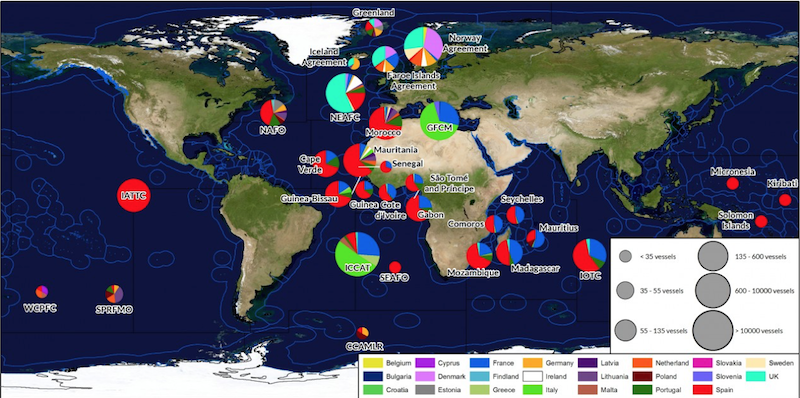Source: Oceana
Author: Vanya Vulperhors
Yesterday’s agreement by EU bodies on a new regulation governing the European Union’s extensive external fishing fleet is a momentous step towards building sustainable fisheries globally and deserves wholehearted praise.
After almost two years of negotiations, the European Commission, the Parliament and the Council of Fisheries Ministers have agreed on a new legal framework to manage the external fishing fleet, estimated to number more than 23,000 vessels[i]. This fleet of EU-flagged vessels operates across the globe and is responsible for 28% of the EU’s total fish catches[1].
The new law hammered out between the EU bodies European Commission, the Parliament and the Council of Fisheries Ministers will:
- make public for the first time official data on which vessels fish where. This will include private agreements – where an EU-flagged vessel makes a direct contract with the government of a non-EU coastal State to fish in its waters – making the EU external fleet the most transparent in the world.
- require the same stringent standards for all vessels seeking authorisation to fish outside EU waters.
- stop so-called abusive reflagging, where a vessel repeatedly and rapidly changes its flag for the purposes of circumventing conservation measures.
- ensure that fishing activities under private agreements meet EU standards. Previously those operating under such agreements were allowed to fish without any EU oversight and were not required to meet any EU management requirements. These vessels were operating under the radar, with no public or EU-wide information available on who fishes where.
The EU external fleet fishes in the waters of many developing coastal states in the Indian and Pacific Oceans and off the coasts of West Africa. The creation of the WhoFishesFar.org database by Oceana and its partners* made clearer than ever the scale and scope of the external fleet’s reach. The database is based on information obtained from the European Commission in response to an access information request and makes public for the first time all fishing authorisations (except private agreements) issued since 2008 when the external fleet regulation was adopted, including foreign vessels fishing in EU waters.
The database shows that during 2008 – 2015:
- Certain fleets such as those of Belgium, Denmark, Estonia and Sweden, tended to operate close to European waters in the North East Atlantic
- France, Germany, Ireland, Latvia, Lithuania, the Netherlands, Poland, Portugal, Spain and UK were authorised to fish off the coasts of West and Central Africa (Cape Verde, Côte d’Ivoire, Gabon, Guinea, Guinea-Bissau, Mauritania, Morocco, São Tomé and Príncipeand Senegal)
- French, Italian, Portuguese, Spanish and UK vessels operated in the Indian Ocean (in IOTC area, and under official EU access agreements with Comoros, Madagascar, Mauritius, Mozambiqueand Seychelles).
- German, Polish and Spanish vessels were authorised to fish in Antarctic waters (in CCAMLR area)
- In the South Pacific vessels from the Netherlands, Latvia, Lithuania, Poland, Portugal and Spain were authorised to fish (in SPRFMO area)
- European flagged vessels that operated in the Western Pacific were all fish carriers (in WCPFC area)

The European Union has worked hard in the past decade to update legislation aimed at achieving legal and sustainable world fisheries at a time of mounting threats to marine biodiversity and food security.
The revised Common Fisheries Policy (CFP) of 2013 aims to ensure that EU vessels fishing within and outside of EU waters meet high standards for sustainability and transparency. The 2010 EU illegal fishing (IUU) Regulation requires that imports of fish from outside its borders are subject to strict controls to make sure they are legally sourced.
The previous external fleet regulation resulted in unfair competition among operators, and prevented EU authorities from ensuring that vessels were fishing legally and sustainably[ii]. The new law removes these inconsistencies, and ensures that all vessels are subject to the same rigorous requirements in order to fish outside of EU waters, fully in line with the principles enshrined in the CFP and and the EU IUU Regulation.
The new law makes the EU’s long distance fishing fleet the most transparent, accountable and sustainable globally. Given the scale and reach of the EU’s fishing activities abroad, this reform could have a significant impact on the long-term conservation and management of global fisheries, as well as on developing coastal states which heavily rely on ocean resources for both food and income.
It is to be hoped that other major players in global fisheries, with fleets spreading their nets ever wider, take heed.
See the official press releases:
*Oceana is working in a coalition of non-governmental organisations to secure the ambitious reform of the EU’s external fleet regulation, as well as the harmonised and effective implementation of the European Union’s Regulation to prevent, deter and eliminate illegal, unreported and unregulated (IUU) fishing.
[1] https://ec.europa.eu/fisheries/cfp/international_en
[i] www.whofishesfar.org shows that between 2008 and 2015 a total of 19,772 individual EU vessels were authorised to fish in the ICCAT area. Of this 19,772, almost half (9,988) were Italian-flagged vessels. In March 2016, the Italian government adjusted the number of Italian vessels targeting swordfish in the ICCAT area, bringing it down from over 8,400 vessels in 2015 to 849 vessels. The review of the external fleet Regulation provides member states with a crucial opportunity to ensure that vessels authorised to fish in Regional Fisheries Management Organisations areas are actually active or operating in these areas. Accurate information on where vessels are fishing and which species they are targeting is vital to ensuring transparency and accountability in global fisheries, and the sustainable management of fish stocks.
[ii] http://www.whofishesfar.org/case-studies
